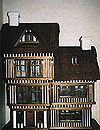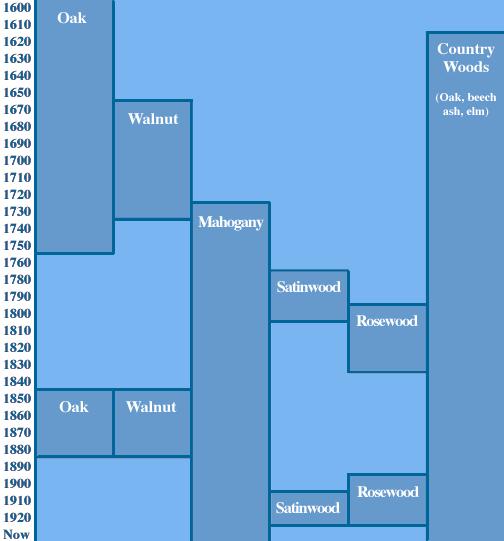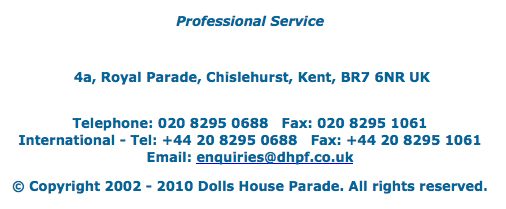
Dolls' House Parade |
"Everything For Your Dolls' House Under One Roof" |
Tel: +44 (0)20 8295 0688 |
Hints & Tips - Periods & Styles
| When we discuss periods and styles we tend to divide the years into neatly definable sections - each with its own particular characteristics. In reality though, the edges are not sharp but blurred. Gradual changes occur rather than sudden transformations. However, in order to conform and to simplify this feature we will use the following table of periods, which are associated with the date ranges shown.
English periods, as with others around the world, revolved around the succession of the monarchs of the time. A new monarch tended to herald the changing of architecture and styles as the country adopted the particular likes, policies and character of the new line of royalty. However, some of these changes can simply be attributed to the passage of time itself and the developments and progress that go with it. Obviously the type of property you are creating (i.e. a palatial mansion or a workers cottage) will dictate the use of style just as much as the period it is set in. The wealthy part of society always adopts changes in style more quickly than the poor. This feature is only intended to give the briefest of summaries and relevant information on periods and styles and should not be treated as a guide to completing dolls houses of any periods. Whole books have been written on the subject we are attempting to guide you through in just a few short paragraphs. If what you require is detailed information in order to create an accurate historical record, then we would recommend reading these books. However, you may find this information useful as long as you always remember our advice to people - and that is: "always create your dolls house in whatever styles or mixtures of styles you like and above all enjoy the project without feeling it necessary to conform to the constraints of any 'rules' or 'formalities'." We will now cover the most popular periods and try to give you an indication as to how other dolls' house collectors have achieved the look of the particular period.
Early Tudor houses were built of timber frame with brick infill, but later in the period full brick construction became more common. The dark oak used together with the poor lighting produced dark and gloomy interiors. However, this feature can be used to create a very atmospheric dolls house
The Georgian house was marked by its plain dignity and elegance. The sense of order and proportion, immediately recognisable in the façade was also reflected inside. Even grand houses that were highly ornamental and full of exquisite detailing still retained a sense of proportion.
A fundamental characteristic of the Regency period is the role of industrial development and, in particular, the mechanisation of processes affecting interior design - such as with wallpapers and fabrics. Great buildings of the time were Buckingham Palace, Marble Arch and The Brighton Pavilion together with many of the Crescents in Brighton.
Victorians adopted past styles for their own purposes. Middle class homes were often over-filled with furnishings and accessories, creating an atmosphere of exaggerated comfort and affluence. Most Victorians lived in simple terraced houses with any staff accommodation in the attic.
Edwardian houses are simpler and more pared down than their Victorian counterparts. Functionality replaced beauty. Architects had grown tired of historical revivals and aimed to create buildings which were more appropriate for the era in which they lived.
Woods by Period
We hope this has given you a feel for the different periods and maybe encouraged some different thoughts for your property. However, we are aware that this feature may have posed more questions than it has answered. If that is the case then we are glad that you have read it and given us the chance to stimulate your mind. We hope you have enjoyed it and it has encouraged you to research further into the times of your dolls' house. If all we have done is add to the confusion then we must remind you of our first rule for the dolls house hobby (mentioned earlier in this feature). "ENJOY IT and don't let conformity spoil that enjoyment". If you have any queries that have not been answered by this feature please contact us on Tel: 020 8295 0688 or Fax: 020 8295 1061 e-mail: info@dhpf.co.uk We will do our best to answer your questions with the help of our own expert builder Dave "Dusty" Caswell. If you need any more help or advice, or have any suggestions for topics you would like to see featured in the future, or you have your own hints and tips you would like to share with your fellow miniaturists, please e-mail us at:
|
![]()
![]()
|
![]()
The best form of advertising is by word of mouth. Read what people say about Dolls House Parade. |
![]()

 Tudor
Tudor Georgian
Georgian Victorian
Victorian



